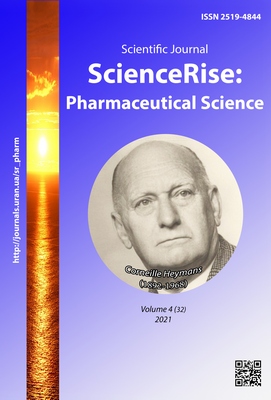Дослідження дозованих інгаляторів під тиском відносно стандартизації показників якості, що характеризують однорідність дозування
DOI:
https://doi.org/10.15587/2519-4852.2021.238294Ключові слова:
дозований інгалятор під тиском, розмір частинок, маса дози, доза, що доставляється, доза дрібнодисперсних частинок, однорідність, методика, валідаціяАнотація
Мета. Обґрунтування доцільності випробування дозованих інгаляторів під тиском (pMDIs) на однорідність дози дрібнодисперсних частинок.
Матеріали та методи. Досліджували pMDIs, що містять суспензії сальбутамолу сульфату (SS) або розчини беклометазону дипропіонату (BD) методами лазерної дифракції та високоефективної рідинної хроматографії (ВЕРХ). Визначали розподіл за розмірами частинок SS, середню масу дози й однорідність маси дози, середню дозу, що доставляється, й однорідність дози, що доставляється, середню дозу дрібнодисперсних частинок та однорідність дози дрібнодисперсних частинок. Дозу дрібнодисперсних частинок визначали на приладі А.
Результати. Проведено валідацію двох методик кількісного визначення SS і BD методом ВЕРХ у діапазонах застосування з низькими концентраціями цих речовин. Досліджено 3 препарати у формі pMDIs, що містять SS, і 2 препарати, що містять BD. Показано, що для трьох препаратів з SS розподіл за розмірами його частинок у балонах і середня доза, що доставляється, майже однакові, але препарати різняться за середньою масою дози та дозами дрібнодисперсних частинок. За результатами досліджень обґрунтовано доцільність визначення середньої маси дози та випробувань з однорідності дозування препаратів за масою дози і за дозою дрібнодисперсних частинок. Показано, що для pMDIs більш однорідним є дозування розчинів BD порівняно з суспензіями SS. Критично обговорені підходи провідних й інших фармакопей до однорідності дозування pMDIs. Обґрунтовано доцільність визначення однорідності дози дрібнодисперсних частинок на етапі фармацевтичної розробки, оскільки саме від дози дрібнодисперсних частинок залежить терапевтичний ефект. Обговорено аспекти стандартизації однорідності дози дрібнодисперсних частинок для pMDIs.
Висновки. Обґрунтовано доцільність стандартизації та контролю якості pMDIs за такими показниками, як середня маса дози, що характеризує об’єм дозуючої камери клапана,однорідність маси дози та однорідність дози дрібнодисперсних частинок, що гарантує терапевтичний ефект кожної дози препарату
Посилання
- The European Pharmacopoeia (2019). European Directorate for the Quality of Medicines & HealthCare of the Council of Europe. Strasbourg, 5224.
- Guideline on the Pharmaceutical Quality of Inhalation and Nasal Products (2006). EMEA/СHМР/QWP/49313/2005 Corr.
- British Pharmacopoeia 2020 (2019). London: The Stationery Office. Available at: https://www.pharmacopoeia.com
- British Pharmacopoeia 2016 (2015). London: The Stationery Office. Available at: https://www.pharmacopoeia.com
- The United States Pharmacopoeia, 41 – NF 36 (2018). The United States Pharmacopoeial Convention. Rockville. Available at: https://opac.kku.ac.th/catalog/Bibltem.aspx?BiblD=b00420302
- Derzhavna Farmakopeia Ukrainy. Vol. 1 (2015). Kharkiv: Derzhavne pidpryiemstvo «Ukrainskyi naukovyi farmakopeinyi tsentr yakosti likarskykh zasobiv», 1128.
- Lippmann, M. (2011). Regional Deposition of Particles in the Human Respiratory Tract. Comprehensive Physiology, 213–232. doi: http://doi.org/10.1002/cphy.cp090114
- Carvalho, T. C., Peters, J. I., Williams III, R. O. (2011). Influence of particle size on regional lung deposition – What evidence is there? International Journal of Pharmaceutics, 406 (1-2), 1–10. doi: http://doi.org/10.1016/j.ijpharm.2010.12.040
- Tougas, T. P., Mitchell, J. P., Lyapustina, S. A. (Eds.) (2013). Good Cascade Impactor Practices, AIM and EDA for Orally Inhaled Products. Springer, 442. doi: http://doi.org/10.1007/978-1-4614-6296-5
- Lyapunov, N. A., Bezuglaya, E. P., Bovtenko, V. A., Stolper, Yu. M. (2018). Comparative assessment of aerodynamic properties of salbutamol pressurized metered dose inhalers. Drug development & registration, 1, 54–61.
- Sheth, P., Stein, S. W., Myrdal, P. B. (2013). The influence of initial atomized droplet size on residual particle size from pressurized metered dose inhalers. International Journal of Pharmaceutics, 455 (1-2), 57–65. doi: http://doi.org/10.1016/j.ijpharm.2013.07.061
- Lyapunov, N. A., Bovtenko, V. A., Bezuglaya, E. P., Stolper, Yu. M. (2016). Obosnovanie novogo podkhoda k otsenke kachestva dozirovannykh aerozoley dlya ingalyatsii na etape ikh razrabotki. Nauchnye vedomosti Belgorodskogo gosudarstvennogo universiteta. Meditsina. Farmatsiya, 226 (5), 170–179.
- Orange Book: Approved Drug Products with Therapeutic Equivalence Evaluations (2020). Available at: www.accessdata.fda.gov/scripts/cder/ob/index.cfm
- Buckingham, R. (Ed.) (2020). Martindale: The Complete Drug Reference. London: Pharmaceutical Press, 4912.
- Note for Guidance on Validation of Analytical Procedures: Text and Methodology, Step 5 (1995). CPMP/ICH/381/95 (ICH Topic Q 2 (R1) Validation of Analytical Procedures: Text and Methodology).
- Lyapunov, N. A., Bezuglaya, E. P., Bovtenko, V. A., Stolper, Yu. M., Baumer, V. N., Bryleva, E. Yu. (2018). Quality risk management for salbutamol pressurized metered dose inhalers. Drug development & registration, 4, 49–61.
- Gosudarstvenniy reestr lekarstvennykh sredstv (GRLS). Available at: http://grls.rosminzdrav.ru
- Derzhavnyi reiestr likarskykh zasobiv Ukrainy. Available at: http://www.drlz.kiev.ua/
- Sheth, P., Sandell, D., Conti, D. S., Holt, J. T., Hickey, A. J., Saluja, B. (2017). Influence of Formulation Factors on the Aerosol Performance of Suspension and Solution Metered Dose Inhalers: A Systematic Approach. The AAPS Journal, 19 (5), 1396–1410. doi: http://doi.org/10.1208/s12248-017-0095-3
- Bovtenko, V. A., Bezuglaya, E. P., Stolper, Yu. M., Lyapunov, N. A. (2018). Izuchenie svoystv preparatov salbutamola sulfata v forme dozirovannykh ingalyatorov pod davleniem. Farmakom, 1, 57–70.
- Gosudarstvennaya Farmakopeya Rossiyskoy Federatsii, XIV izdanie. Vol. 1 (2018). Moscow: Ministerstvo zdravookhraneniya Rossiyskoy Federatsii, 1814.
- Guideline on the Requirements for Clinical Documentation for Orally Inhaled Products (OIP) Including the Requirements for Demonstration of Therapeutic Equivalence between two Inhaled Products for Use in the Treatment of Asthma and Chronic Obstructive Pulmonary Disease (COPD) in Adults and for Use in the Treatment of Asthma in Children and Adolescents (2009). CPMP/EWP/4151/00 Rev. 1.
- Note for Guidance on Pharmaceutical Development, Part I (2009). EMEA/CHMP/167068/2004 (ICH Topic Q 8 (R2) Pharmaceutical Development.
- Murtaza, G., Ahmad, M., Madni, M. A., Asghar, M. W. (2009). A new reverse phase HPLC method with fluorescent detection for the determination of salbutamol sulfate in human plasma. Bulletin of the Chemical Society of Ethiopia, 23 (1), 1–8. doi: http://doi.org/10.4314/bcse.v23i1.21292
- Patel, N., Parmar, V. K. (2018). A Sensitive High-Performance Thin Layer Chromatography Method for Simultaneous Determination of Salbutamol Sulphate and Beclomethasone Dipropionate from Inhalation Product. Pharmaceutical Sciences, 24 (2), 131–140. doi: http://doi.org/10.15171/ps.2018.20
##submission.downloads##
Опубліковано
Як цитувати
Номер
Розділ
Ліцензія
Авторське право (c) 2021 Elena Bezuglaya, Nikolay Lyapunov, Vladimir Bovtenko, Igor Zinchenko, Yurij Stolper

Ця робота ліцензується відповідно до Creative Commons Attribution 4.0 International License.
Наше видання використовує положення про авторські права Creative Commons CC BY для журналів відкритого доступу.









